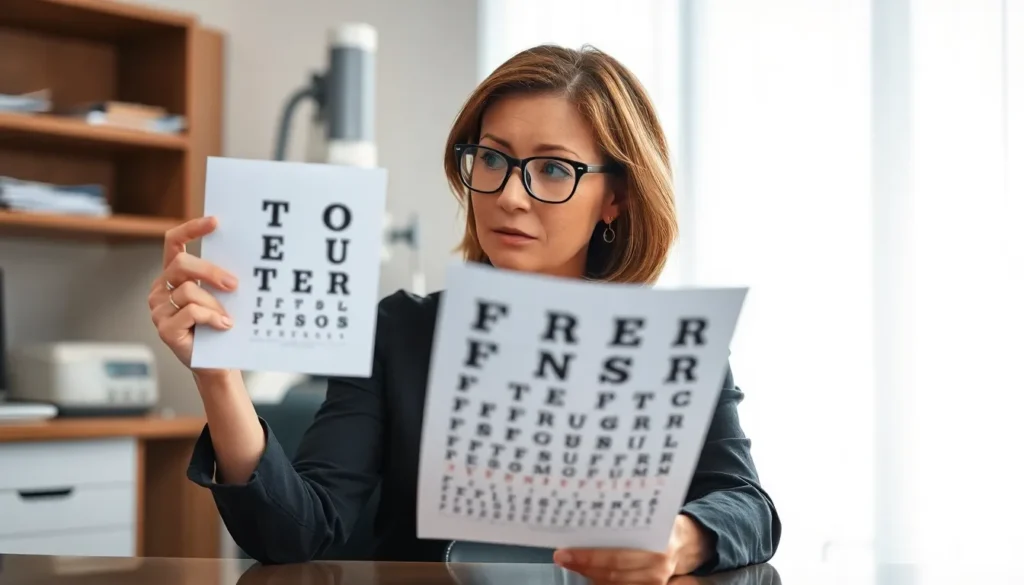Imagine waking up one day and realizing your world’s gone a bit wonky. You’re not dizzy; you might just be dealing with homorzopia disease. This quirky condition might sound like a character from a sci-fi movie, but it’s a real concern that can affect vision and perception. So how do you find out if you’ve got it?
How to Test for Homorzopia Disease
Homorzopia disease affects an individual’s vision and perception. This condition leads to a distortion in how objects appear, creating challenges in daily activities. People experiencing homorzopia often describe their surroundings as warped or unclear.
Symptoms of homorzopia may include difficulties with depth perception, blurred vision, or a sensation of objects moving unexpectedly. Visual disturbances often become more pronounced in environments with contrasting light, such as bright sunlight or flickering artificial lights. Individuals might find navigating crowded spaces or reading difficult, impacting overall quality of life.
Diagnosis typically involves a thorough eye examination and assessment of visual function. Medical professionals often conduct tests measuring contrast sensitivity, visual acuity, and depth perception. Analyzing these areas helps identify visual dysfunctions associated with homorzopia.
Awareness of this disease remains essential. Early recognition can lead to more effective management strategies, reducing the impact on daily life. Research continues to explore potential causes, including genetic factors or neurodegenerative conditions that may contribute to its development.
Healthcare providers play a critical role in conveying information about homorzopia. Patients must understand the nature of their condition and available treatment options. Education equips individuals to make informed decisions about their visual health and seek appropriate support.
Understanding homorzopia disease enhances awareness and encourages timely intervention. Timely assessments and proper care can significantly improve visual experiences for those affected.
Symptoms of Homorzopia Disease

Homorzopia disease presents various symptoms that impact vision and perception. Some individuals may experience challenges that affect daily life.
Common Symptoms
Distorted vision ranks among the most reported symptoms of homorzopia disease. Blurred vision often accompanies this distortion, making it difficult to focus on nearby objects. Depth perception problems arise, leading to difficulties in estimating distances. Frequent headaches may occur, often attributed to the strain of trying to see clearly. Light sensitivity also presents a challenge, particularly in environments with strong contrast.
Severe Symptoms
Severe symptoms can significantly hinder daily functioning. A pronounced sense of disorientation often overwhelms individuals, especially in unfamiliar settings. Visual hallucinations may manifest, creating additional confusion and unease. Difficulty reading text, especially in low-light scenarios, represents another concern for those affected. Occasional loss of balance can occur, making navigation precarious. Reporting severe symptoms to a healthcare provider is essential for timely and effective diagnosis.
Testing Methods for Homorzopia Disease
Testing for homorzopia disease involves several approaches to accurately assess visual distortions. Healthcare professionals employ a range of methods, including physical examinations, laboratory tests, and genetic testing, to establish a diagnosis.
Physical Examination
Physical exams start with a comprehensive assessment of eye health. An eye specialist conducts visual assessments, evaluating visual acuity and depth perception. Patients may undergo tests to check response to varying light conditions, highlighting contrast sensitivity. Observing eye movement can also reveal underlying issues, assisting in identifying symptoms of homorzopia. Regular check-ups enhance understanding of visual changes over time.
Laboratory Tests
Laboratory tests supplement physical examinations by providing quantitative data on visual function. These tests can involve advanced imaging technologies, assessing the retina and optic nerve. Objective measures of visual performance, including contrast sensitivity thresholds, contribute to a clearer diagnosis. Results from laboratory tests inform treatment plans tailored to individual needs. Consistent data collection enables tracking of disease progression or improvement over time.
Genetic Testing
Genetic testing serves as a crucial component for patients with a family history pertinent to homorzopia. Providers may recommend testing to identify specific genetic mutations linked to the disease. Identifying genetic markers aids in understanding predisposition and potential progression of the condition. Knowledge gained from genetic testing can guide proactive management strategies. Genetic information empowers patients and providers to make informed decisions, enhancing visual health outcomes.
Interpreting Test Results
Interpreting test results for homorzopia disease requires careful analysis. Positive results indicate the presence of visual dysfunctions, showing significant discrepancies in contrast sensitivity and depth perception. These findings often correlate with the symptoms experienced, such as distorted vision and light sensitivity. When tests reveal severe visual impairments, healthcare providers recommend further assessments and tailored treatment plans. Additionally, genetic counseling may be suggested for individuals with positive results, particularly if there are familial links to the disease.
Negative results suggest that the visual system functions properly. Such outcomes may not rule out the presence of homorzopia, as the condition may involve subtle dysfunctions not easily detected through standard tests. Further investigations, including advanced imaging or specialized tests for visual processing, might be necessary. Even with negative results, individuals are encouraged to monitor any persistent symptoms. Regular follow-up appointments help ensure early intervention if new issues arise, maintaining optimal visual health.
experiencing its challenging symptoms
Understanding how to test for homorzopia disease is vital for those experiencing its challenging symptoms. Early detection through comprehensive eye examinations and specialized tests can lead to more effective management strategies. Individuals should remain vigilant about their visual health and seek professional guidance when symptoms persist. By staying informed and proactive, they can navigate the complexities of this condition and improve their quality of life. With ongoing research and advancements in testing methods, there’s hope for better outcomes and enhanced visual experiences for those affected by homorzopia disease.
